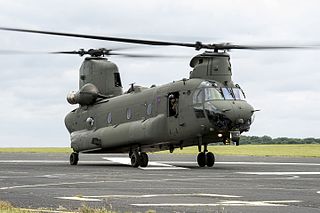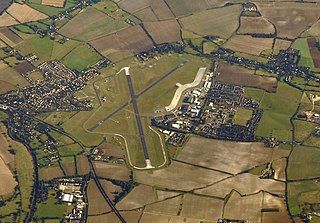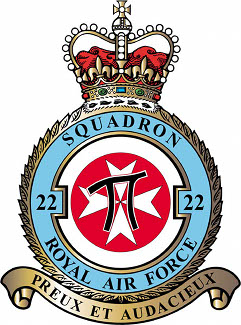
The Army Air Corps (AAC) is the aviation arm of the British Army, first formed in 1942 during the Second World War by grouping the various airborne units of the British Army. Today, there are eight regiments of the AAC, as well as two independent flights and two independent squadrons deployed in support of British Army operations around the world. Regiments and flights are located in the United Kingdom, Kenya, and Canada. Some AAC squadrons provide the air assault elements of 16 Air Assault Brigade, through Joint Helicopter Command.

No. 206 Squadron is a Test and Evaluation Squadron of the Royal Air Force. Until 2005 it was employed in the maritime patrol role with the Nimrod MR.2 at RAF Kinloss, Moray. It was announced in December 2004 that 206 Squadron would disband on 1 April 2005, with half of its crews being redistributed to Nos. 120 and 201 Squadrons, also stationed at Kinloss. This was a part of the UK Defence Review called Delivering Security in a Changing World; the Nimrod MR.2 fleet was reduced in number from 21 to 16 as a consequence.

Royal Air Force Odiham or more simply RAF Odiham is a Royal Air Force station situated a little to the south of the village of Odiham in Hampshire, England. It is the home of the Royal Air Force's heavy lift helicopter, the Boeing Chinook, and of the King's Helicopter Flight (TKHF). Its current station commander is Group Captain Matt Roberts.

Royal Air Force Benson or RAF Benson is a Royal Air Force (RAF) station located at Benson, near Wallingford, in South Oxfordshire, England. It is a front-line station and home to the RAF's fleet of Westland Puma HC2 support helicopters, used primarily for the transportation of troops & equipment. Flying squadrons comprise No. 33 Squadron flying the Puma, No. 22 Squadron which provides operational evaluation and training for all aircraft in Joint Aviation Command and No. 28 Squadron, which is the combined Puma and Boeing Chinook HC6A training unit. Other units include the Oxford University Air Squadron and No. 6 Air Experience Flight, both flying the Grob Tutor T1 light training aircraft used for student and cadet flying training. The National Police Air Service and the Thames Valley Air Ambulance are also based at the station, both operating Airbus H135 helicopters.

Joint Helicopter Command Flying Station Aldergrove, also known as simply JHC FS Aldergrove, is a British military base located 4.4 miles (7.1 km) south of Antrim, Northern Ireland and 18 miles (29 km) northwest of Belfast, and adjoins Belfast International Airport. It is sometimes referred to simply as Aldergrove which is the name of a nearby hamlet.

Number 28 Squadron, also known as No. 28 Squadron or No. 28 (AC) Squadron, is a squadron of the Royal Air Force. Based at RAF Benson, it serves as the RAF's Operational Conversion Unit for the Westland Puma HC2 and Boeing Chinook HC5/6/6A helicopters.

Number 22 Squadron of the Royal Air Force is an operational testing and evaluation squadron for all the Joint Aviation Command helicopter types including Chinook, Puma HC2, Merlin HC4, AH-64E Apache and Wildcat AH1. Formerly the Rotary Wing Operational Evaluation and Training Unit, the highly experienced helicopter aircrew will also ensure frontline crews have Qualified Warfare Instructors to support them on operations worldwide. The squadron was reformed in May 2020 to serve as the Joint Aviation Command Operational Evaluation Unit.

No. 202 Squadron of the Royal Air Force is the maritime and mountains training element of the No.1 Flying Training School, operating the Airbus Helicopters H145 Jupiter.

Number 33 Squadron of the Royal Air Force operates the Airbus Helicopters Puma HC.2 from RAF Benson, Oxfordshire.

The Joint Aviation Command (JAC), previously known as Joint Helicopter Command (JHC), is a tri-service organisation uniting battlefield military helicopters of all three services of the British Armed Forces and unmanned aerial vehicles of the British Army for command and coordination purposes.
No. 695 Squadron RAF was an anti-aircraft co-operation squadron of the Royal Air Force from 1943 to 1949.

667 Squadron AAC is a former squadron of the British Army's Army Air Corps (AAC).

Number 72 (Fighter) Squadron of the Royal Air Force is a training squadron that is currently based at RAF Valley using the Beechcraft Texan T.1 to deliver Basic Fast Jet Training (BFJT).
No. 228 Squadron RAF was a squadron of the Royal Air Force active at various times between 1918 and 1964. It spent the greatest part of its existence flying over water, doing so in the First, and Second World Wars and beyond, performing anti-submarine, reconnaissance and air-sea rescue tasks.
No. 240 Operational Conversion Unit RAF is a former Royal Air Force Operational conversion unit which was formed by a series of mergers, it then became No. 27 Squadron RAF in 1993.
No. 292 Squadron RAF was an air-sea rescue (ASR) squadron of the Royal Air Force operating in the Bay of Bengal during the Second World War.
No. 240 Squadron RAF was a Royal Air Force flying boat and seaplane squadron during World War I, World War II and up to 1959. It was then reformed as a strategic missile squadron, serving thus till 1963.

No. 657 Squadron AAC was a squadron of the British Army's Army Air Corps (AAC), part of the Joint Special Forces Aviation Wing based at RAF Odiham. The squadron disbanded in May 2018 after the retirement of the Westland Lynx.
No. 660 Squadron AAC is a squadron of the British Army's Army Air Corps (AAC). It was formerly No. 660 Squadron RAF, a Royal Air Force air observation post squadron associated with the 21st Army Group during the Second World War. Numbers 651 to 663 Squadrons of the RAF were air observation post units working closely with British Army units in artillery spotting and liaison. A further three of these squadrons, 664–666, were manned with Canadian personnel. Their duties and squadron numbers were transferred to the Army with the formation of the Army Air Corps on 1 September 1957.

No. 1563 Flight Royal Air Force was an independent flight of the Royal Air Force (RAF). The flight formerly operated the Westland Puma HC2 helicopters in Brunei Darussalam. It previously flew tactical support missions for locally garrisoned British Army units, as well as Belize Defence Force units in Belize. Between 1963 and 1972, it was stationed at RAF Akrotiri flying Westland Whirlwind HAR.10 helicopters on support missions for locally garrisoned British Army and United Nations troops.

















